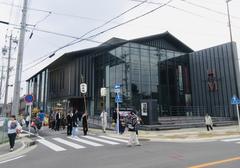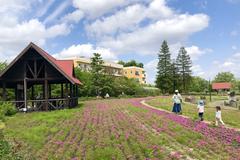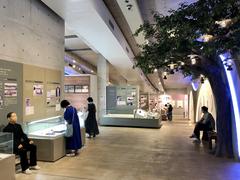Visiting Onojo Castle: History, Tickets, and Travel Tips
Publication Date: 25/07/2024
Overview of Onojo Castle
Onojo Castle, also known as Ōno Castle, is a historical fortification that stands as a testament to Japan’s ancient military ingenuity and architectural prowess. Located in Handa, Japan, the castle’s origins date back to the Asuka Period (538-710 AD), a time when Japan was under constant threat from neighboring kingdoms such as Silla and Tang China. Constructed under the reign of Emperor Tenchi in 665 AD, Onojo Castle served as a strategic defensive stronghold designed to protect the Dazaifu administrative center, a crucial hub for governance and diplomatic relations in ancient Japan. The castle’s location on a hilltop provided a natural vantage point for monitoring enemy movements and defending the surrounding area (Wikipedia).
The castle is a remarkable blend of traditional Japanese and continental architectural elements, featuring multiple layers of defensive walls, gates, and watchtowers. It was built with the help of exiles from the Baekje Kingdom, incorporating Korean-style fortress techniques. Onojo Castle’s historical significance extends beyond its military role, as the site has yielded numerous archaeological discoveries, including the Ushikubi Sue Ware Kiln Site, which underscores the region’s cultural and economic importance during the Asuka Period (Wikipedia).
Today, the ruins of Onojo Castle are preserved as a significant cultural heritage site, offering visitors a unique opportunity to explore Japan’s ancient past. The site is accessible year-round and free of charge, making it an inviting destination for history enthusiasts and casual tourists alike. With well-maintained walking trails, scenic views, and nearby attractions, Onojo Castle provides a well-rounded experience that blends historical exploration with modern amenities (Japan Guide).
Contents
- Historical Background of Onojo Castle
- Origins and Construction
- Role in Regional Defense
- Architectural Features
- Historical Significance
- Decline and Preservation
- Visiting Onojo Castle
- Ticket Prices
- Opening Hours
- Accessibility
- Nearby Attractions
- Modern-Day Onojo
- FAQ
- Introduction
- Conclusion
Historical Background of Onojo Castle
Origins and Construction
Onojo Castle, located in Handa, Japan, has a rich history that dates back to the Asuka Period (538-710 AD). The castle was constructed as a defensive stronghold to protect the region from potential invasions by Silla and Tang China. The strategic location of the castle on a hilltop provided a vantage point for monitoring enemy movements and defending the surrounding area. The name ‘Onojo’ itself is derived from the kanji characters for ‘big,’ ‘field,’ and ‘castle,’ reflecting its significance as a major fortification in the region (Wikipedia).
Role in Regional Defense
During the Asuka Period, Japan faced threats from neighboring kingdoms, prompting the construction of several defensive structures, including Onojo Castle. The castle, along with nearby Mizuki Castle, played a crucial role in safeguarding the Dazaifu, an important administrative center in ancient Japan. The Dazaifu was responsible for governing the Kyushu region and maintaining diplomatic relations with foreign powers. Onojo Castle’s strategic location and robust defenses made it a key component of the region’s military infrastructure (Wikipedia).
Architectural Features
Onojo Castle was designed with a combination of traditional Japanese and continental architectural elements. The castle’s layout included multiple layers of defensive walls, gates, and watchtowers, which were constructed using locally sourced materials such as stone and wood. The castle’s hilltop location provided natural defenses, while the man-made fortifications enhanced its ability to withstand sieges and attacks. The design of Onojo Castle reflects the military ingenuity of the period and the influence of continental fortification techniques (Wikipedia).
Historical Significance
Onojo Castle’s historical significance extends beyond its military role. The castle and its surrounding area have been the site of numerous archaeological discoveries, including the Ushikubi Sue Ware Kiln Site. This site provides evidence of the region’s importance as a major producer of Sue ware pottery, a type of high-fired stoneware that was widely used in ancient Japan. The presence of such artifacts highlights the cultural and economic significance of the area during the Asuka Period (Wikipedia).
Decline and Preservation
Following the end of the Asuka Period, Onojo Castle’s importance as a military stronghold gradually declined. However, the castle and its ruins have been preserved as a historical site, offering visitors a glimpse into Japan’s ancient past. Efforts to preserve and study the castle’s remains have provided valuable insights into the architectural and military practices of the period. Today, Onojo Castle is recognized as an important cultural heritage site, attracting history enthusiasts and tourists alike (Wikipedia).
Visiting Onojo Castle
Ticket Prices
Visitors can explore the ruins of Onojo Castle free of charge. There are no ticket fees required, making it an accessible historical site for everyone.
Opening Hours
The castle ruins are open to the public year-round. Visitors are welcome to explore the site from sunrise to sunset, ensuring ample time to appreciate the historical significance and natural beauty of the area.
Accessibility
The castle ruins are accessible via several walking trails that lead up the hill, providing scenic views of the surrounding area. The trails are well-maintained, making them suitable for visitors of all ages and fitness levels. Additionally, the city of Onojo offers various amenities, including free parking lots around the base of the castle hill, ensuring a convenient and enjoyable visit (Japan Guide).
Nearby Attractions
In addition to Onojo Castle, visitors can explore other historical sites in the area, such as Mizuki Castle and the Ushikubi Sue Ware Kiln Site. These sites offer further insights into the region’s rich cultural and historical heritage. The city of Onojo also boasts modern attractions, including shopping centers, restaurants, and cultural events, providing a well-rounded experience for tourists.
Modern-Day Onojo
The modern city of Onojo, located in Fukuoka Prefecture, continues to honor its historical roots. The city has developed around the castle ruins, blending modern urban development with the preservation of its historical landmarks. Onojo’s population, as of March 31, 2024, is estimated to be 102,818, with a population density of 3,800 persons per square kilometer. The city’s total area is 26.89 square kilometers, making it a vibrant and bustling urban center with a rich historical heritage (Wikipedia).
FAQ
What are the visiting hours for Onojo Castle?
The castle ruins are open to the public from sunrise to sunset.
Do I need to buy tickets to visit Onojo Castle?
No, visiting Onojo Castle is free of charge.
Are there amenities around Onojo Castle?
Yes, there are free parking lots and well-maintained walking trails.
Conclusion
Onojo Castle stands as a testament to Japan’s ancient history and military ingenuity. Its strategic location, architectural features, and historical significance make it a must-visit destination for history enthusiasts and tourists alike. The preservation of the castle ruins and the surrounding area’s development into a modern urban center ensure that Onojo’s rich heritage continues to be celebrated and appreciated by future generations. For more information on visiting Onojo Castle and other historical sites in Fukuoka, download the Audiala app and follow us on social media.



